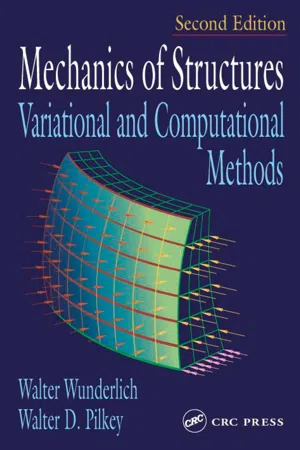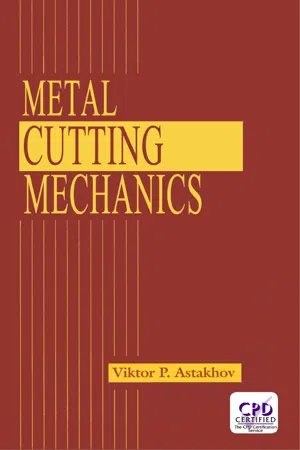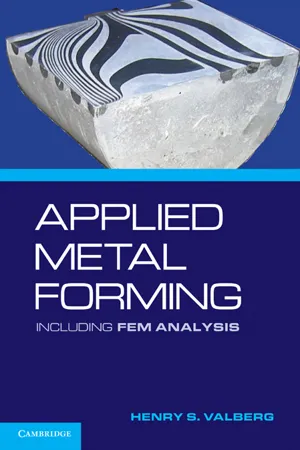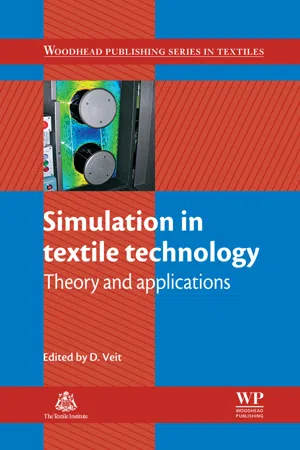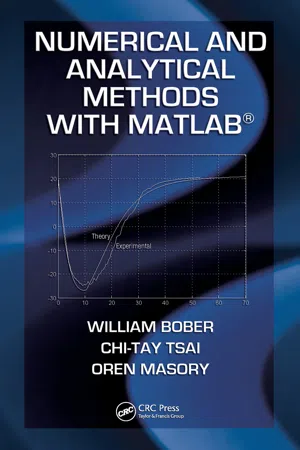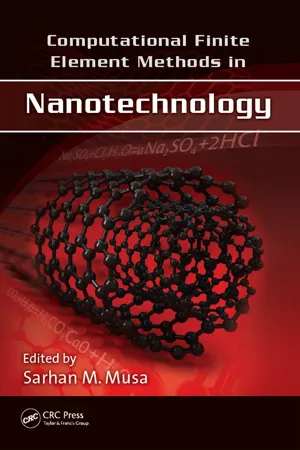Technology & Engineering
Finite Element Modeling
Finite Element Modeling is a computational technique used to analyze and simulate complex physical systems. It involves dividing a structure or system into smaller elements to accurately predict its behavior under various conditions. By applying mathematical equations and algorithms, Finite Element Modeling helps engineers and researchers understand stress, strain, and other physical phenomena, aiding in the design and optimization of structures and materials.
Written by Perlego with AI-assistance
Related key terms
1 of 5
11 Key excerpts on "Finite Element Modeling"
- eBook - PDF
Mechanics of Structures
Variational and Computational Methods
- Walter Wunderlich, Walter D. Pilkey(Authors)
- 2002(Publication Date)
- CRC Press(Publisher)
6 The Finite Element Method The finite element method is the dominant computational tool of contemporary structural and solid mechanics. It permits difficult problems of complicated geometry to be solved with relative ease. A number of finite element-based general purpose computer programs for analysis and design are available to the engineer. These programs can be used to solve an array of difficult structural engineering problems. An introduction to finite element tech-nology from the viewpoint of the structural mechanics philosophy of this book is presented in this chapter. The finite element method has its origins in the matrix methods of structural analysis (Chapter 5). Some four decades ago it was recognized to be an emerging viable com-putational method for solid mechanics with applications to many problems of structural analysis. Since then, a mathematical basis for finite elements has been developed and applications have been expanded to include fluid mechanics, heat transfer, biomechan-ics, geomechanics, and acoustics. This ever-widening applicability of the finite element method is due in part to its common formulation based on the variational principles. Also, one-, two-, and three-dimensional problems are handled in like fashion with a uniform notation. Technical histories of the finite element method are provided in Clough (1990), Felippa (1994), and Gupta and Meek (1996). Biographies of some of the pioneers in the development of finite element technology are available in Robinson (1985). The method can be considered as a natural evolution of the standard methods of structural mechanics for frames modeled as discrete elements, or as an approximate solution technique for continuum mechanics pro-blems utilizing a regionally discretized model with assumed strain patterns for the regions. - eBook - PDF
- Viktor P. Astakhov(Author)
- 1998(Publication Date)
- CRC Press(Publisher)
chapter five Finite element simulation 5.1 General The finite element method (FEM) is firmly accepted as a powerful general technique for the numerical solution of a variety of problems encountered in engineering. For linear systems, at least, the technique is widely employed as a design tool. However, similar acceptance for nonlinear situations is not so obvious. Before FEM can be used in design, its accuracy must be proven. The development of improved element characteristics and more efficient nonlin-ear solution algorithms along with experience gained in their applications allow the technique to be performed with some confidence. The objective of this chapter is to describe in detail the application of FEM to simulation of the metal cutting process which is a materially nonlin-ear engineering analysis· problem. The physical meaning of each step in analysis and the problems that arise in simulations are the main focus. 5.1.1 FEM in metal cutting As shown in Chapter 2 , FEM seems to be most suitable for analyzing the state of stress and deformation in the cutting system. This method has been applied to simulate machining since 1973 with some success. I -12 The devel-opment of this approach, its history and assumptions, and the techniques involved have been well summarized by Zhang and Bagchi. 9 Although earlier studies of metal cutting using FEM provided useful insight into the cutting process, they were all based on the oversimplified model of the cutting process known as the shear-plane model. As such, the contact condition at the tool/ chip interface was modeled as simple friction, or, at best, the law governing the normal and shear stresses at the too1/ chip interface was assumed to be known . - eBook - PDF
Applied Metal Forming
Including FEM Analysis
- Henry S. Valberg(Author)
- 2010(Publication Date)
- Cambridge University Press(Publisher)
Process simulation using FEA has yielded considerable cost and quality improvements in the industry. FEM simulation has become a practical and efficient tool for prediction of performance in industrial forming operations before dies are manufactured. Today, FEA is an extremely effective tool for research and also in industrial applications. FEM programs can predict large deformations and thermally influenced mate- rial flow in metal forming. Thus, they can provide detailed information about the forming mechanics. FEM simulation of metal forming is highly complex and compu- tation intensive. This is due to extreme nonlinearities because of large strains, plas- tic flow of anisotropic materials, with interfacial friction between irregular-shaped surfaces under changing contact. Because of this, it is difficult to obtain analytical solutions to such problems for quantitative evaluation of temperature, stress, and strain distributions, within the deforming body. It is therefore common to use the FEM for this purpose. 14.3.1 FEM Modeling Approach In FEM modeling, 1 the workpiece is represented by a collection of subdomains called finite elements; see Fig. 14.1. The elements are bounded by sets of nodes. They define localized mass and stiffness properties of the model. Equations of equi- librium, in conjunction with applicable physical considerations such as compatibility and constitutive relations, are applied to each element to construct a system of equa- tions. The system is then solved to find unknown values using advanced numerical techniques. FEA is an approximate method, and its accuracy can be improved by increasing the number of elements used. - eBook - PDF
Finite Element Method for Solids and Structures
A Concise Approach
- Sung W. Lee, Peter W. Chung(Authors)
- 2021(Publication Date)
- Cambridge University Press(Publisher)
These simple problems are chosen to describe the essential features of the FE method which are common to analysis of more complicated structural systems such as three-dimensional (3D) bodies. In the example problems given in this chapter, we will try to keep the solutions in non- dimensional form. This will render the solutions valid for any geometric properties such as body length and cross-sectional area, material properties, and the magnitude of applied loads. Similar practices will be followed in subsequent chapters to the extent possible. 1.1 Overview of the Finite Element Method The FE method is a powerful technique that can be used to analyze mathematical models on computers. Models are highly specialized for a particular type of analysis. Throughout this book, we will focus largely on the types of mechanics problems of interest to mechanical, aerospace, and civil engineers. More broadly, however, the types of models encountered, and the ways in which they are studied, are not unlike those seen in other disciplines. We may follow a workflow like the one shown in Figure 1.1. 1 The workflow starts with a real-life system. In real life, the system of interest may be a structural member or part that serves an important mechanical purpose. It may sit within a larger system and function in a well-defined role, and it must then be designed to perform in a manner sufficient for the needs of the larger system. The physical model is then identified through, for instance, a phenomenological concept such as “linear elasticity,” “thermoviscoplasticity,” “inviscid flow,” or “thermal diffusion.” This model must carefully account for the context of the later analysis. For instance, if the model is intended to study the response and failure of a structure, the physical model must possess features that could be used for that purpose. The mathematical model is a complete mathematical statement of the problem in question. - eBook - ePub
Principles of Electron Optics, Volume 1
Basic Geometrical Optics
- Peter W. Hawkes, Erwin Kasper(Authors)
- 2017(Publication Date)
- Academic Press(Publisher)
Chapter 12The Finite-Element Method (FEM)
Abstract
The finite-element method employs an irregular mesh based on small triangular elements. This has the advantage that curved boundaries can be fitted to the mesh. Once again, a set of linear relations between potential or field values in adjoining elements is established and solved either by iteration of by direct matrix inversion.Keywords
Finite elements; saturation; round lenses; multipoles; imperfect systemsThough the basic ideas and equations of the finite-difference method (FDM) are very simple, the practical application of this method to boundary-value problems can become extremely tedious if the boundaries are of an irregular shape. In the finite-element method (FEM), this difficulty is removed by the use of general triangular grids, as is shown in Fig. 12.1 . Such grids can be fitted to any shape of boundary, once the latter has been represented approximately by a polygon. Since the numerical differentiation now becomes very complicated, partial differential equations are not considered here. Instead, the equations governing the values of the potential at the nodes of the grid are derived directly from an appropriate variational principle (see Section 6.3 ).Figure 12.1 Finite-element discretization; this example concerns the vacuum part of a meridional section through a round magnetic lens.The FEM was proposed by Courant (1943) . It came into practical use with the development of modern computers and has found widespread application in mechanical and electrical engineering. Typical examples are problems in fluid dynamics and aerodynamics, elasticity, heat conduction and magnetic field computations for electric machines (Chari and Silvester, 1980 ). For further details we refer to the books of Zienkiewicz (1967 , 1971 , 2013) . Some mathematical problems associated with the FEM were treated in detail by Norrie and de Vries (1973) . In electron optics, the FEM was first used by Munro (1971 , 1973) , who applied it to the computation of magnetic fields in round lenses. Since this is of especial interest in electron optics, we concentrate on this application without neglecting electrostatic fields, including those in electron guns. A section is devoted to deflection units and multipoles. The presentation of the FEM given below differs from Munro’s version in the introduction of form functions and in the unification of the methods for saturated and unsaturated lenses. For further background information, see Munro (1980 , 1987a ,b) , Kasper (1987a ,b ,c) , Morton (1987) and Reid (1987) . Many aspects of the method are developed in more detail in a book by Kasper (2001) ; a monograph on The Finite-Element Method in Charged Particle Optics has been written by Khursheed (1999) - Robert King(Author)
- 2018(Publication Date)
- Cengage Learning EMEA(Publisher)
Due to electronic rights, some third party content may be suppressed from the eBook and/or eChapter(s). Editorial review has deemed that any suppressed content does not materially affect the overall learning experience. Cengage Learning reserves the right to remove additional content at any time if subsequent rights restrictions require it. Chapter 1 Overview of the Finite Element Analysis Process 2 of the systems, but exact solutions at any location using analytical models are usually not pos-sible due to the complicated nature of industrial-scale systems. Solving numerical models with a computer is called simulation. FEM simulations can be applied to many classes of problems, but this text focuses on solid mechanics, or mechanics of materials, problems. Solid mechanics simulations calculate the stresses and displacements/ deformation in an object with known boundary conditions. Because the objects can be very complex, the software divides the object into many (sometimes millions) of small, finite ele-ments. The discretized mathematical models solve for displacement and stress in each ele-ment. The elements are connected through common points called nodes. The results from the individual elements are combined to determine stress and displacement at discrete locations throughout the model by solving a large set of simultaneous algebraic equations. The model might be a single object like a bolt, or it can be a complicated assembly of objects. This text explains the FEA process with fundamentals and active learning investigations. It uses the SOLIDWORKS Simulation (SWS) software provided by Dassault Systèmes (http://www. solidworks.com/sw/products/simulation/simulation.htm) in the active learning investigations. To get the most out of the active learning experience, you should have SOLIDWORKS Simulation available on a computer so you can work the examples as they are presented.- Jyoti Kumar Sinha(Author)
- 2014(Publication Date)
- CRC Press(Publisher)
23 3 Introduction to Finite Element Modeling 3.1 Basic Concept Real-life systems and structures, such as civil structures, bridges, piping systems, etc., are continuous systems. The mathematical modeling using the standard differential equations based on theory may be complicated for such systems, and their solution would be even more complex. However, the mathematical models are important for several requirements, which include design, impact of design modification, vibration behavior, etc. Any small change in the system may require complete new formulation all over again using the standard differential equations based on the elasticity theories (Fenner, 1986). Considering these difficulties, nowadays the finite element (FE) modeling method is most popular, well accepted, and useful to meet the requirements perhaps in a much simpler than the earlier approach. The simplified concept of the FE method is presented in this chapter through a few simple examples to aid understanding and visualizing of FE model-ing and analysis either through in-house developed computational code or through any commercially available FE codes. The well-known textbooks by Zienkiewicz and Taylor (1994) and Cook et al. (1989) can be referred to for further details of the FE method and modeling if needed. 3.1.1 Degree of Freedom (DOF) It is always assumed that a simple helical coil spring can take the load and related deflection in a direction only; hence, it has just one degree of freedom at any point of the spring. It is illustrated in Figure 3.1. However, other struc-tures may have a number of DOFs at a location, which is illustrated through a beam, as shown in Figure 3.2, subjected to the following loadings: 1. Axial load in the x -direction: It produces the deflection of the beam in the x -direction only at any point on the beam. This deflection DOF is represented here by x e , where e denotes the location on the beam.- eBook - ePub
Simulation in Textile Technology
Theory and Applications
- D Veit(Author)
- 2012(Publication Date)
- Woodhead Publishing(Publisher)
The user interface includes special integration of FEM core software into the engineering CAD. This allows the constructors to check the strength and deformation of the parts during development. Such tools use well-proven families of elements and include only the main functionalities of the FEM method, usually only linear analysis. The majority of FEM programs today have an improved user interface and are not so hard to use in the preprocessing as they were many years ago. The new, better models with high order elements and special materials are also a current research area and trend.With the huge increase in computer power in recent years, the FEM developer tries to use the power of the several CPUs and use libraries for parallel processing of the data. This allows more complex simulations to be performed within a shorter time, e.g. multiscale computations. The multiscale approach requires more computer power and is based on creating models at different levels of the structure. For instance, micro- or meso-models are used during the calculation of the properties of the unit cells, and these properties are then used to perform the simulation of the macro-structure. Most of the FEM packages provide also the possibilities for coupled simulations or multiphysics, where the interaction between fluids and structure, electric, magnetic or heat fields can be performed at the same time.X-FEM (extended finite element method) is an extension of the FEM for structures with discontinuities. A typical example are composites, where the properties of the material in a unit cell are derived by homogenization techniques by the properties of both interfaces and their geometry (Fries, 2011 ). Particle FEM is another new method. It is able to deal with particles of fluids and solid bodies, which is a very powerful tool for fluid–structure interaction simulations (Idelsohn et al - J. Noye(Author)
- 2000(Publication Date)
- North Holland(Publisher)
520 References . . . . . . . . . . . . . . . . . . . . . . . . . . . . . . . . . . . . . . . . . . . . . . . 522 Finite EZement Method 4 79 ABSTRACT The finite element method i s a numerical method originally invented by engineers o u t of necessity t o solve complex practical problems. I t later attracted the interest of mathematicians who recognised i t s place amongst known mathematical procedures. This allowed t o generalise the method and to use i t w i t h confidence in other fields. Fast and large computers made possible applications to more and more complicated practical problems a t reasonable cost. General purpose computer codes written by engineers appeared allowing the solution of a wide range of problems by one code and with minimum theoretical knowledge required by the user. The finite element method became a tool for an engineer and scientist comparable with other experimental procedures used in the practice. The success unfortunately ( b u t naturally) often led to an overconfidence of the users who forgot t h a t the computer cannot replace clear understanding of the fundamentals of the method, experience and skill i n modelling real structures and t o coupling techniques and theory correctly and efficiently together. The correct usage for the future progress of the method i s in close cooperation of mathematicians, scientists, computer programmers and users. This paper tries t o de- monstrate how an engineer understands the finite element method and i t s application. INTRODUCTION I t i s essential t o distinguish four areas of interests in the finite element methods, each on i t s own very important for the future development and usage of the technique. Firstly, mathematical theory of the method, which has t o work with idealised models of reality in order t o achieve generalisation, i s essential for mathematical validity of specific approaches and for future direction of the technique as a whole.- eBook - PDF
- William Bober, Chi-Tay Tsai, Oren Masory(Authors)
- 2009(Publication Date)
- CRC Press(Publisher)
283 13 Chapter An Introduction to the Finite Element Method C. T. Tsai 13.1 Finite Element Method for Stress Analysis The finite element method is a powerful mathematical tool to numerically calculate the stresses and deformation in structures with complicated geometry, boundary conditions, and material properties. For a two-dimensional stress analysis prob-lem, a solution can be obtained by solving a partial differential equation (PDE) in MATLAB ® , where a complicated geometry can be built and meshed. Then the PDE can be discretized on the mesh and solved, providing an approximate solu-tion. The pdetool graphical user interface in MATLAB provides easy-to-use graphi-cal tools to describe complicated domains and to generate triangular meshes. It also discretizes PDEs, finds discrete solutions, and plots results. To overview the fundamentals of the finite element method (FEM) and understand how finite ele-ment formulations are developed for various PDEs, a structural mechanics plane stress problem is described below. 13.2 Structural Mechanics Plane Stress Analysis In structural mechanics, the equations relating stress and strain arise from the applied forces and constraints in the material medium. Plane stress is a condition that prevails in a flat plate in the ( x , y ) plane, loaded only in its own plane and without z -direction restraints; that is, all the stress components in the z direction vanish. 284 ◾ Numerical and Analytical Methods with MATLAB A general description of plane stress at any point of a solid is shown in Figure 13.1, where all the stress components in the z direction ( σ z , t yz , and t xz ) are zero. - Sarhan M. Musa(Author)
- 2017(Publication Date)
- CRC Press(Publisher)
15 Finite Element Method (FEM) for Nanotechnology Application in Engineering: Integrated Use of Macro-, Micro-, and Nano-Systems Radostina PetrovaTechnical University of Sofia, Sofia, BulgariaP. GenovaBulgarian Academy of Science, Sofia, BulgariaM. TzonevaTechnical University of Sofia, Sofia, BulgariaCONTENTS 15.1 Introduction 15.2 Basic Idea and Applied Methods 15.3 Examples 15.3.1 Clamps for Operating with Micro or Nano Objects 15.3.1.1 Background of the Problem 15.3.1.2 Aim of the Example 15.3.1.3 Description of the Finite Element Model 15.3.1.4 Solution for a Set of Materials 15.3.1.5 Numerical Experiments and Results 15.3.1.6 Conclusions on the Cited Numerical Example 15.3.2 Analysis and Design of Parallel Micro-Robot Structures 15.3.2.1 Why Tripod Structure? 15.3.2.2 Aim of the Provided Example 15.3.2.3 Description of the Established Mathematical Model and of the Developed Solution Strategy 15.3.2.4 Numerical Examples for Outlining the Accessible Zone of the Vertex of the Controlled Link 15.3.2.5 FEM of a Spatial Three-Pod Mechanism with Three Built-in Drives 15.3.2.6 Conclusions on the Preceding Numerical Example 15.3.3 Kinematics of a Macro-Mechatronic System 15.3.3.1 Analytical Solution 15.3.3.2 Finite Element Solution 15.3.3.3 Conclusions on the Preceding Example 15.3.4 Analysis and Synthesis of Mechanical Bioreactors for Bio-Nanotechnologies 15.3.4.1 Short Review of Existing Devices for Bioreactor Systems 15.3.4.2 Kinematics of Spatial Mechanisms in Biotechnologies 15.3.4.3 Conclusions on the Preceding Example References 15.1 Introduction“The step from micro-technology to nano-technology requires more than a reduction of the size by a factor of a thousand. If you want to move precisely in the nano-world, you don’t succeed by perfecting proven techniques.” This statement of Handelsblat is cited by Klocke and Gesang (2002) and describes briefly the innovative approach in nanoscience.
Index pages curate the most relevant extracts from our library of academic textbooks. They’ve been created using an in-house natural language model (NLM), each adding context and meaning to key research topics.
